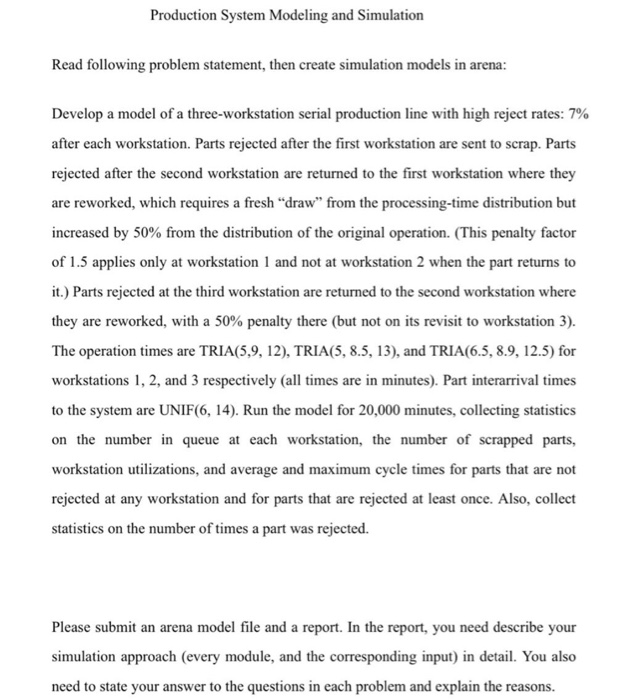Production System Modeling and Simulation Read following problem statement, then create simulation models in arena: Develop a model of a three-workstation serial production line with high reject rates: 7% after each workstation. Parts rejected after the first workstation are sent to scrap. Parts rejected after the second workstation are returned to the first workstation where they are reworked, which requires a fresh "draw" from the processing-time distribution but increased by 50% from the distribution of the original operation. (This penalty factor of 1.5 applies only at workstation 1 and not at workstation 2 when the part returns to it.) Parts rejected at the third workstation are returned to the second workstation where they are reworked, with a 50% penalty there (but not on its revisit to workstation 3). The operation times are TRIA(5,9, 12), TRIA(5, 8.5, 13), and TRIA(6.5, 8.9, 12.5) for workstations 1, 2, and 3 respectively (all times are in minutes). Part interarrival times to the system are UNIF(6, 14). Run the model for 20,000 minutes, collecting statistics on the number in queue at each workstation, the number of scrapped parts, workstation utilizations, and average and maximum cycle times for parts that are not rejected at any workstation and for parts that are rejected at least once. Also, collect statistics on the number of times a part was rejected. Please submit an arena model file and a report. In the report, you need describe your simulation approach (every module, and the corresponding input) in detail. You also need to state your answer to the questions in each problem and explain the reasons. Production System Modeling and Simulation Read following problem statement, then create simulation models in arena: Develop a model of a three-workstation serial production line with high reject rates: 7% after each workstation. Parts rejected after the first workstation are sent to scrap. Parts rejected after the second workstation are returned to the first workstation where they are reworked, which requires a fresh "draw" from the processing-time distribution but increased by 50% from the distribution of the original operation. (This penalty factor of 1.5 applies only at workstation 1 and not at workstation 2 when the part returns to it.) Parts rejected at the third workstation are returned to the second workstation where they are reworked, with a 50% penalty there (but not on its revisit to workstation 3). The operation times are TRIA(5,9, 12), TRIA(5, 8.5, 13), and TRIA(6.5, 8.9, 12.5) for workstations 1, 2, and 3 respectively (all times are in minutes). Part interarrival times to the system are UNIF(6, 14). Run the model for 20,000 minutes, collecting statistics on the number in queue at each workstation, the number of scrapped parts, workstation utilizations, and average and maximum cycle times for parts that are not rejected at any workstation and for parts that are rejected at least once. Also, collect statistics on the number of times a part was rejected. Please submit an arena model file and a report. In the report, you need describe your simulation approach (every module, and the corresponding input) in detail. You also need to state your answer to the questions in each problem and explain the reasons







